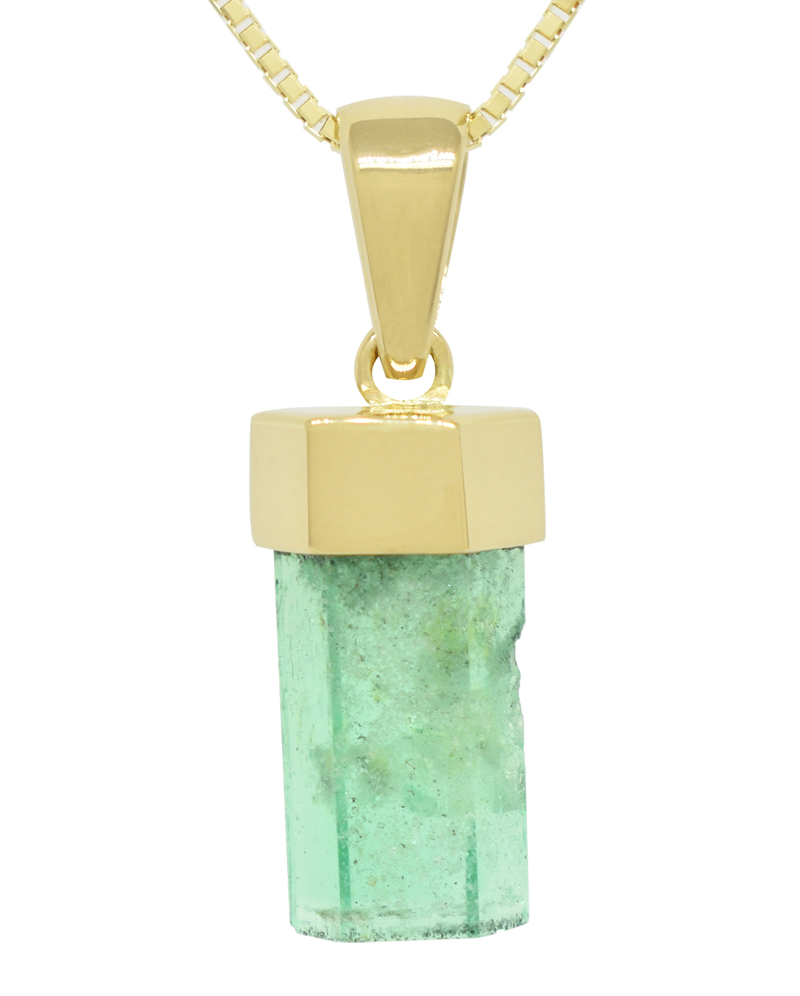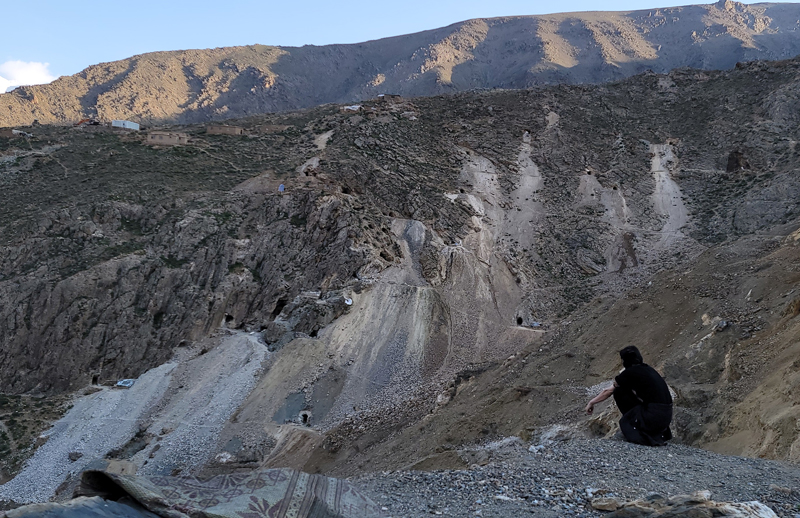
[ad_1]
By Diana Jarrett

Photo courtesy Jose Rodriguez/Queen Emerald
From time immemorial, precious stones have been the favoured muse of distinguished authors. The emerald in particular is found referenced in ancient biblical scriptures, in the prolific writings of Pliny the Elder, and generously peppered throughout Shakespeare’s sonnets and plays.
Indeed, A Lover’s Complaint, penned by the English playwright in 1609, posits emerald to be so potent, it holds the power to revive one’s eyesight: “The deep-green emerald, in whose fresh regard, weak sights their sickly radiance do amend.”
This notion of emerald’s facility to repair (or at least soothe) eyesight holds some veracity amongst the diamond trade as well. It is known that traditional diamond graders often kept an emerald in their pocket as a tool to recover from ocular strain caused by focusing on diamonds hour after hour—gazing at the cool, grassy tint of an emerald was said to soothe the stressed eye. Gemstone cutters have also been known to keep an emerald nearby to glance at and relieve eye-fatigue after long hours of concentration while working at the bench.
Emerald’s lively upbeat tint brings to mind new life and spring growth, making it an ideal birthstone for the month of May. It is also the gemstone for 20th and 35th wedding anniversaries.
This venerated beryl variety, which is part of the trinity of precious stones (emerald, ruby, and sapphire), has gathered legions of famous devotees over the centuries. First-century AD Roman emperor Nero had flat emerald crystals fashioned into a kind of early Ray-Bans and wore them to ward off sun glare while watching the gladiators in Rome’s Coliseum.
The earliest known emerald mines of record were found in Egypt, dating back to at least 330 BC. Those mine sites continued producing into the early 18th century. Cleopatra, an emerald enthusiast, had such a passion for the lush stone that she kept her own mines. Much of her regal embellishments were lavishly encrusted with the green sparklers.
When 16th century Spaniards invaded the ‘New World’ in what is now Colombia, part of their coveted loot were hordes of emerald stones. By this time, the region’s indigenous Incas had considered emeralds treasured accessories and been using them as part of religious ceremonies for more than 500 years. Emeralds made their way back to Spain, where they created an appetite for the jewels amongst European and Asian royalty.
Today, emerald lovers have several places to source these alluring green stones.
“Most clients typically ask for Colombian emeralds, not realizing other localities also produce them,” says Alan Hackman, a partner at Intercolor USA. “You can also find emeralds from Brazil, Afghanistan, Ethiopia, or Zambia.”
Additionally, while some are coming out of Madagascar, he says, “Currently, the most commonly found emeralds come from Zambia, and that’s mainly due to Gemfields mining company doing a great job selling them at their auctions.”
Zambian emeralds are considered among the oldest on earth, created by an enigmatic confluence of beryllium, chromium, and vanadium merging some 500 million years ago.
“Chromium and vanadium make an intense green colour,” according to the Gemological Institute of America (GIA). “Iron gives the stone a bluish tint.”
As for other emerald locales, mining of the stones in Afghanistan has never been better, says veteran gem hunter Gary Bowersox, president of Geovision Inc., in Honolulu—and he should know. Bowersox has spent decades hunting gems in the region, while also advocating for local Afghani artisanal miners and gem dealers.
“Production is up,” he says. “The Afghanistan government is finally working with the miners to legally export their rough emeralds.”
Meanwhile, in Colombia, there are several locales synonymous with excellent material and natural emerald, reports Jose Rodriguez, owner of Queen Emerald Natural Colombian Emeralds and Fine Jewelry.
“In the state of Boyaca, in the middle of Colombia, you will find the three most important mines that produce the best quality emeralds in the world: Muzo, Coscuez, and Chivor,” he says.
The geology of each terrain is key to the eventual formation of green (chromium bearing) beryl crystals. These alluring stones may take shape in hydrothermal (hot fluid) veins deep within the earth’s crust if the necessary conditions are met. The hot fluids must contain enough concentrated chemical elements needed to form an emerald crystal. This will start taking shape as the hydrothermal fluids begin cooling down in deposit veins. It is believed all emeralds sourced from Colombia were formed this way. The gems are often said to be associated with calcite deposits which were also formed via the hydrothermal process.

Photo courtesy Gary Bowersox, Geovision Inc.
Not all emeralds were created in hydrothermal veins—some got their start in pegmatite deposits. Similar to hydrothermal veins, however, pegmatite’s method includes the primary agent of magma or molten rock. As the magmatic rock starts to cool, some elements are left behind in the remaining fluid. When the necessary elements are present and if conditions line up perfectly, emerald crystals begin forming in these pegmatites.
As one can imagine, the various geological conditions greatly impact the colour and look of emeralds found throughout the world. As for one’s preference to a specific hue, this is strictly a matter of personal taste.
“Typically, Colombian stones are produced in yellowish-greens, while Zambian material usually has a bluish secondary hue,” Hackman says.
Besides colour cues to their origin, he explains, “In general, Colombian rough is more included as opposed to Zambian crystals, which are often more transparent.”
While Hackman admits his personal taste gravitates toward the Colombian colours, he adds, “Due to the quantities currently available in the market, Zambian emeralds probably account for more sales. Interestingly enough, Afghanistan is now producing emeralds nearly identical to Colombian stones in colour and grade but are selling at about 30 to 40 per cent less.”
Recovering emerald crystals from their host rock is an arduous task, irrespective of where they are located. Concerted effort is made to dislodge the green crystals from their tough domain, usually from rocks layered with other minerals like mica. Open pit mining or terrace mining are the most common emerald recovery methods. High-pressure water can be utilized to blast away the host and reveal mineral-bearing rocks.
When deeper rock layers need to be accessed, tunnels are dug to reach emeralds believed to have formed there. A method of blast and drill (B&D) is employed to get to otherwise inaccessible veins. This action is thought to increase the concussive fractures that are emblematic of emeralds.
Bowersox frames his difficult pursuit of chasing down gemstones into a personal perspective.
“I just returned from a month in Afghanistan, where I travelled into the Hindu Kush Mountains to review the operations at the emerald mine sites in Panjshir Valley,” he says. “Climbing to more than 13,000 feet was no easy task now that I have passed my 80th year. This was my 50th year to explore and work in Afghanistan.”
He reflects on the similarities of emerald extraction in Colombia and Afghanistan, saying, “I was in the Colombian emerald mines in 2015. Unless Colombia mining has changed, both mining is similar, except the tunnels are not as deep or as well-supported in Afghanistan. Both countries are blasting and drilling.”
Fortunately, for emerald, inclusions are not deal breakers.
“Clarity is important,” Rodriguez affirms, “but I think what makes a Colombian emerald different from any other emerald is its colour. The ‘grass green’ hue with a bluish hint that makes it show up from any piece of jewellery is something magical and unique, which no other gemstone can create. It makes every single emerald different and sometimes challenging to match, even for small earring sets.”
![Afghanistan emerald. [CREDIT] Photo courtesy Gary Bowersox, Geovision Inc.](https://www.jewellerybusiness.com/wp-content/uploads/2021/12/20210613_073742-1.jpg)
Photo courtesy Gary Bowersox, Geovision Inc.
Emeralds are known for having inclusions. Indeed, it is both expected and accepted for this particular gemstone to have a number of natural flaws inside the crystal. In fact, dealers caution anyone to be suspect of finding an emerald void of these telltale signs.
The most commonly known emerald inclusion-types are called jardin within the trade (which translates in both French and Spanish to ‘garden’). These iconic emerald inclusions resemble moss or plant branches. Since each set of jardin inclusions are unique to a crystal, they help identify a specific stone.
Some professionals claim certain jardin can indicate an emerald’s origin, too. While it may not be completely possible to determine a gemstone’s country of origin solely from its jardin-like inclusions, certain geological locales are more likely to produce crystals with region-typical markings.
“Emeralds typically contain inclusions visible to the unaided eye,” Rodriguez says. “Because of this, trade members and consumers understand and accept their presence.”
He adds, “Inclusions are a big part of natural emeralds, and you expect to see them. The most important part is not the inclusions by themselves, but their layout inside the emerald and if they may compromise the gem’s durability in a setting.”
However, Rodriguez also notes the difference in certain types of emerald inclusions.
“You do not want many fissures that may create a cloudy or milky appearance in the gemstone,” he says. “You will always want to have a transparent crystal-like appearance in an emerald.”
As emeralds are known for their many internal flaws, the goal for achieving complete transparency has always been strong. There are many ways to achieve the appearance of higher clarity and greater transparency with emeralds.
Nearly all emeralds are produced with surface-reaching fractures. Thus, fracture filling, for example, is an age-old process used to improve the appearance of emeralds. Cedar oil is one often used means of improving a stone’s clarity and salability. However, oil treatments may not be stable or permanent. Over time, exposure to heat or even careless cleaning may cause the oil to dissipate or change colour. The solution is for the stone to be professionally re-oiled.
Resins (either natural or synthetic) are another treatment option, boasting a longer lifespan prior to drying out. Canadian balsam, a natural substance, or created resins and polymers appear to be more durable and long-lasting than oiling products alone. A caution with this procedure, however, is it is almost impossible to remove the resin (if needed). This is especially true when hardeners have been added to prolong the lifespan of the treatment.
Depending on where the emerald treatment is performed, these methods vary from primitive to highly advanced.
“The Afghans are treating emeralds with oil, but have yet to develop modern, current oil treatments using vacuum equipment,” Bowersox says. “To my knowledge, they are not yet using resin. That doesn’t mean that some Afghan emeralds might be treated outside of Afghanistan with resin and then returned to be sold inside of Afghanistan.”
Green-coloured oil, like Joban, has also been applied to improve the colour of emeralds, though it is not highly favoured in the trade, owing to the amount of change produced in the stone.
More than anything, although emeralds are ‘expected’ to have undergone treatment, it is vital to maintain full disclosure along the pipeline—straight to the consumer. Various treatments require different types of handling. Thus, if a piece of emerald jewellery requires a trip to the bench, appropriate forewarning is mandatory to waylay any unexpected consequences. Cleaning emerald jewellery is another area where one needs to be mindful. Different treatments require specific cleaning methods to keep the treatment intact.
Inclusions, treatments, and caveats notwithstanding, emeralds are the darling of the coloured stone realm. As avidly collected today as they were in Cleopatra’s time, these gorgeous green gems remain so popular, the demand often outweighs the supply.
“As with any other coloured gemstone, fine quality emeralds are very high in demand, and there aren’t enough quantities to satisfy the market’s need for them,” Hackman says. “The same scenario applies to rubies, sapphires, and most other coloured gems.”
|
AUTHOR’S NOTE: MINING IN AFGHANISTAN |
|
Days after I spoke to Gary Bowersox for this article, the gem hunter was heading to Dubai for a conference between Afghan gems miners, dealers, and foreign buyers, sponsored by the United States Agency for International Development (USAID). The event has now been postponed until November 2021, leaving more than US$25 million in emerald inventory in Dubai. Following recent events in Afghanistan, Bowersox has stayed in touch with friends and colleagues in the country via social media. While it is premature to say for certain what the future holds for Afghanistan, he says, “Gemstones always continue to sell even though it becomes more difficult. Any new government will want to continue with exports including gemstones.” |
 Diana Jarrett is an award-winning trade journalist and graduate gemmologist (GG). A registered master valuer, Jarrett is a popular conference and trade show lecturer. She is also the co-author of Cameos Old & New (4th Edition) and the co-creator of JewelryWebsiteDesigners.com. Jarrett can be reached at [email protected] or through www.dianajarrett.com.
Diana Jarrett is an award-winning trade journalist and graduate gemmologist (GG). A registered master valuer, Jarrett is a popular conference and trade show lecturer. She is also the co-author of Cameos Old & New (4th Edition) and the co-creator of JewelryWebsiteDesigners.com. Jarrett can be reached at [email protected] or through www.dianajarrett.com.
[ad_2]
Source_link